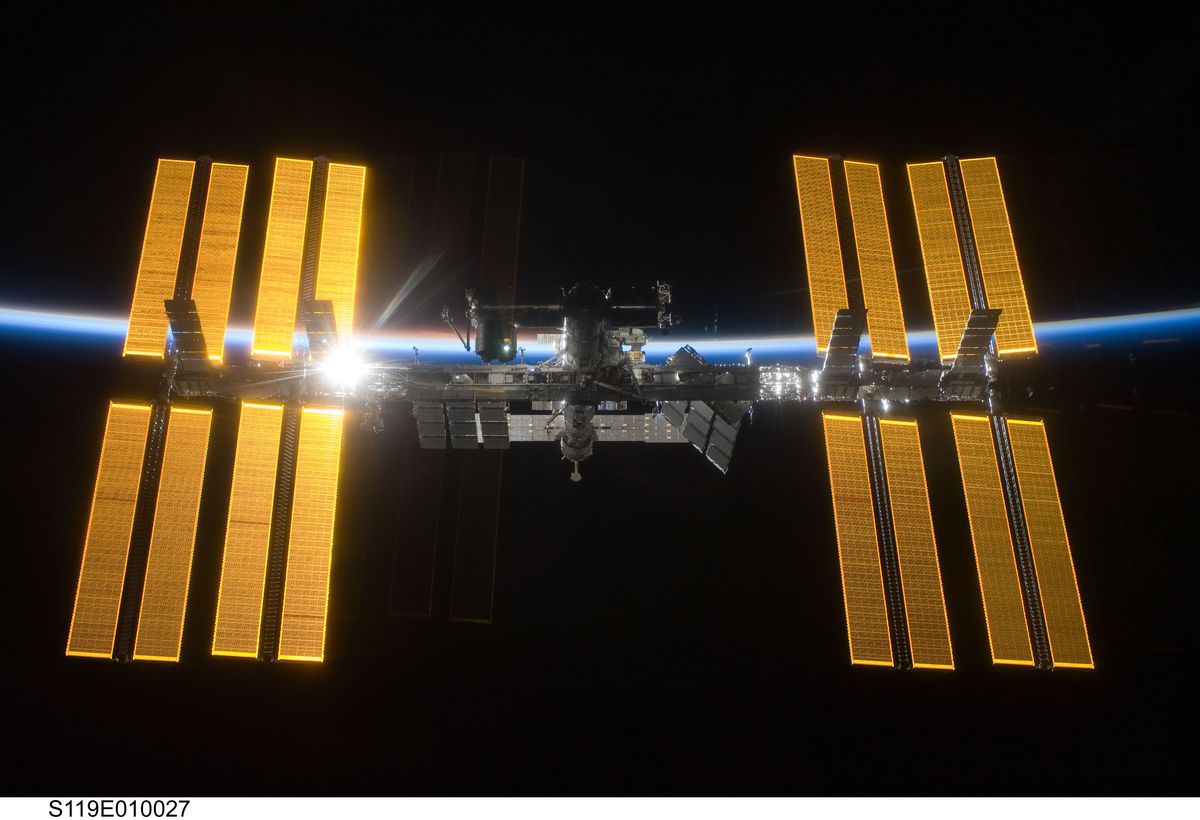[ad_1]
As the war in Ukraine goes on, there’s a looming threat that Russia might ditch the International Space Station — a football field-sized satellite that currently houses several astronauts — and allow it to crash into Earth. This raises two scary questions. One, can Russia just drop the ISS on the planet? And two, is the post-Cold War era of space collaboration between Russia and the US coming to an end? The answers are complicated.
The uncertain state of the ISS reflects the rift between its two main partners, who are currently clashing over Russia’s ongoing war against Ukraine. Concerns that Russia might let the ISS fall to Earth came up late last month when Russian space chief Dmitry Rogozin raised the idea in a series of tweets complaining about new US sanctions against Russia, including some aimed at its space program. The issue came up again this week after Rogozin suggested on a state-controlled Russian television show that if the US continued to be “hostile,” Roscosmos would rescind its support for the space station.
But even if the ISS stays in orbit for now — and it almost certainly will — these ongoing tensions are a clear sign that the state of international collaboration in space is rapidly changing, and becoming much more sensitive to politics here on Earth.
The safety of the ISS is a real concern. Russia controls critical aspects of the space station’s propulsion control systems. While the ISS is in orbit, Earth’s gravity gradually pulls it toward the atmosphere, so the space station typically uses a propulsion module — which is controlled by Russia — to keep it in place. Without these regular boosts, though, the ISS would very slowly fall toward the atmosphere, where it would mostly burn up. The astronauts aboard would likely have plenty of time to escape the space station and travel back to Earth. But some of us might not be as lucky: a number of heavy components that make up the ISS could survive the atmosphere and fall to the Earth’s surface, where, without control over the ISS’s deorbit, they could hit structures or kill people.
Again, there are many reasons why this is unlikely to happen. For one, NASA insists everything is fine. Rogozin is also known for bombastic statements. Destroying the space station isn’t necessarily to Russia’s advantage, either. Roscosmos, Russia’s space agency, may not want to take the risk of an uncontrolled deorbit, even if the ISS doesn’t normally travel over much of Russia. And then there’s the fact that just as NASA depends on Roscosmos to keep the ISS operational, Roscosmos also depends on NASA, and has a long history of working with the US, even through periods of tension. This is the nature of the ISS’s founding partnership, which is now more than two decades old.
“The current situation is a result of decisions made basically 29 years ago to build a space station that was interdependent with Russia and the United States at its core,” John Logsdon, the founder of George Washington University’s Space Policy Institute, told Recode. “This dependence on Russia for propulsion was not an accident.”
The future of space may not look as cooperative, though. Like the US, Russia wants to travel to the moon, Mars, and, eventually, Venus and Jupiter. But as Roscosmos’s waning commitment to the ISS makes clear, the space agency doesn’t seem so interested anymore in working closely with the US. Instead, Roscosmos is gearing up to lead its own space explorations and work with other countries on its efforts, rather than NASA. This race is already playing out on the moon. After the US announced the Artemis program, a NASA-led international effort to explore and establish a human presence on the lunar surface, Russia and China announced that they would team up in a separate partnership to do something similar.
We don’t know exactly how these new politics of space will play out. We also don’t know whether Russia’s war on Ukraine will force the country to go it alone in space. But we do know that tensions between Russia and the US are driving Roscosmos and NASA apart. This is setting the groundwork for a new era of space collaboration, one that doesn’t involve a singular international partnership, like the ISS does, but rather several different factions of space-faring countries that sometimes will work together and sometimes won’t. As Roscosmos’s reaction to the war in Ukraine makes clear, this could become very tricky very quickly.
The ISS’s last legs
Politics isn’t supposed to influence the ISS. Russia and the US first started building the space station in the late 1990s, and the partnership was considered a major feat of international collaboration, especially in the wake of the Cold War and the decadeslong space race. Since then, the ISS has brought together astronauts from around the world to conduct research that could, eventually, help bring humans even further into outer space. The ISS partnership now includes 15 different countries, and is considered by some to be humanity’s greatest achievement — and one that has mostly been above whatever is happening on planet Earth.
This is increasingly not the case. Back in 2014, Russia used the ISS in an attempt to pressure the US into recognizing its annexation of Crimea, a peninsula in the southern part of Ukraine (and which Ukraine still considers to be part of its territory). If the US didn’t formally recognize Russia’s claims on the region, the Russian space program suggested it would relocate astronaut training to Crimea. This was a critical threat at the time: NASA astronauts needed training to travel on Russia’s Soyuz rocket, which, back then, was the only way to get to the ISS. The conflict came just months after the US instituted sanctions that were meant to punish Russia for its invasion of Crimea. In response, Roscosmos had implied it would stop transporting any NASA astronauts at all, with Rogozin suggesting in a tweet that the US “bring their astronauts to the International Space Station using a trampoline.”
:no_upscale()/cdn.vox-cdn.com/uploads/chorus_asset/file/23286646/GettyImages_1349715994.jpg)
:no_upscale()/cdn.vox-cdn.com/uploads/chorus_asset/file/23286660/GettyImages_147504944.jpg)
“There has been a sense that the ISS is starting to become a bargaining chip of some sort in relations between the United States, in particular, and Russia,” explains Wendy Whitman Cobb, a professor at the US Air Force’s School of Advanced Air and Space Studies.
The good news is that the US is no longer dependent on Roscosmos for transportation to the ISS; SpaceX has been transporting NASA astronauts to the space station since 2020. The not-so-good news is that Russia seems to care less and less about the ISS. Russia threatened to withdraw from the space station partnership last year — again over US sanctions.
The situation became even grimmer this past fall when Russia blew up a defunct spy satellite with an anti-satellite missile and created thousands of pieces of space debris, including some that US officials feared could damage the ISS. This test didn’t just highlight that Russia has the ability to shoot down a satellite from Earth, but that it was potentially willing to endanger its own ISS cosmonauts, who were forced to shelter in emergency vehicles for several hours after the test.
Things degraded even further this week. The Russian space agency announced it will no longer work with Germany on science experiments on the ISS, and also said that it will stop selling rocket engines to the US, which NASA has historically depended on. And Rogozin again raised the idea that without Russia’s help, NASA would need to find another way to get to the ISS. This time, he suggested “broomsticks.”
“It is likely that Russia could exit the ISS given the geopolitical situation of Ukraine before 2025,” explained Namrata Goswami, an independent scholar of space policy. “If Russia ends up leaving the ISS earlier than 2025 due to the Ukraine crisis, it will be difficult to quickly develop the Russian support cycle for the ISS.”
Despite the war, NASA has tried to keep up the appearance of normalcy aboard the ISS. The agency has posted updates about science experiments happening aboard the space station and even put on a press conference promoting the first privately crewed mission to the ISS, which is scheduled for later this month. But behind the scenes, the US is racing to figure out what an ISS without Russia might look like. One company, Northrop Grumman, has already volunteered to build a propulsion system that would replace Russia’s, and Elon Musk has suggested on Twitter that SpaceX could help too.
These efforts might keep the ISS up and running without Russia for a few years, but the space station won’t be around forever. NASA still plans to vacate the ISS by the end of the decade, at which point it will be slowly deorbited over a remote part of the Pacific Ocean, clearing the way for new space stations to take its place. This includes China’s Tiangong space station; Tiangong’s first module launched into orbit last May — astronauts already live aboard — and the station is supposed to be complete by the end of 2022. The US is also funding several new commercial space stations, and Russia and India both plan to launch their own national space stations in the coming decade. Because these stations will generally be under the purview of one specific country, they probably won’t be as catholic as the ISS is.
Russia is charting a new course in space
Some of Russia’s near-term plans in space haven’t been affected by its ongoing war with Ukraine, at least for now. Astronaut Mark Vande Hei, for instance, is still scheduled to travel back to the Earth on Russia’s Soyuz vehicle at the end of this month, along with two cosmonauts. Russia and the US are collaborating on training sessions, NASA said on Monday. The agency is also working on plans to carry cosmonaut Anna Kikina on SpaceX’s Crew Dragon later this year. But other aspects of Russia’s space agenda are now up in the air, and possibly signal Roscosmos’s new approach.
For one, deteriorating relations between Europe and Russia have already impacted their work in space: The European Space Agency (ESA) — which represents 22 European countries — has issued a statement recognizing sanctions against Russia. In response, Roscosmos has delayed the launches of several satellites at Europe’s spaceport in French Guiana that were supposed to use Russia’s Soyuz rocket. Separately, the Russian space agency is also in a standoff with the UK over plans to launch into orbit 36 satellites from the satellite internet company OneWeb. Roscosmos was supposed to deliver these satellites (again using Soyuz) on March 4, but is now refusing to do so unless the UK sells its stake in the company and promises that the satellites won’t be used by its military. The UK, which has declared its own sanctions against Russia, has said it’s not willing to negotiate.
:no_upscale()/cdn.vox-cdn.com/uploads/chorus_asset/file/23286676/GettyImages_1232472085.jpg)
:no_upscale()/cdn.vox-cdn.com/uploads/chorus_asset/file/23286666/GettyImages_1171027813.jpg)
Plans for missions that will go deeper into outer space are also changing. Days after Russia attacked Ukraine, Romania announced that it would join the Artemis Accords. Fifteen other countries, including Poland and Ukraine, have already signed on to the NASA-led set of principles, which are meant to guide how countries explore outer space. And although Roscosmos was supposed to send a robot to Mars sometime this year alongside the ESA, officials say these plans are now “very unlikely.” Rogozin has also announced Russia will bar the US from its eventual plan to send a mission to Venus. Rocosmos’s Rogozin, for what it’s worth, has previously suggested that Venus is a “Russian planet.”
We don’t yet know how Russia’s war with Ukraine might impact its collaboration with China’s space program, the China Manned Space Agency (CMSA). In the past few years, the two countries’ space agencies have developed wide-ranging plans to work together in space, including an effort to build a base on the moon. It isn’t surprising that CMSA would work with Roscosmos over NASA. The US has largely excluded China from its work in space: A 2011 US law bars NASA from collaborating with China’s space agency, and no astronaut from China has ever visited the ISS. This prohibition is a reminder that the ISS has never been as “international” as its name implies, and has also given CMSA ample reason to build a sophisticated space program on its own.
But that doesn’t mean that Russia and China’s space relations are a sure bet. While Roscosmos’s Rogozin has argued that Roscosmos can sidestep sanctions by buying space technology from China, there’s reason to believe that might not happen. China hasn’t quite backed Russia’s invasion of Ukraine; it may be wary of getting on the wrong side of sanctions. India, which agreed to collaborate with Russia in space at the end of last year, might also reconsider its relationship with Russia’s space program for the same reasons.
It’s not yet clear how much this might matter to Russia. Again, Roscosmos has plans to build its own national space station, which it aims to complete in 2025, and the Russian space agency has already started work on the station’s first core module. Then there’s the fact that Russia was a leader in the space race long before it started working with the ISS.
And there’s always the possibility that Roscosmos comes around and reconciles with NASA. After all, the Soviet Union and the US did try to work together in space throughout the Cold War — even as the two countries also tried to outdo each other, explains Teasel Muir-Harmony, the curator of the Apollo collection at the Smithsonian National Air and Space Museum.
“There’s always been the combination of both competition and cooperation in space between the US and Russia,” said Muir-Harmony. “It waxes and wanes. It’s a fascinating thing.”
[ad_2]
Source link


